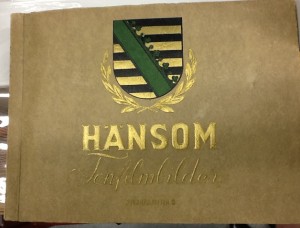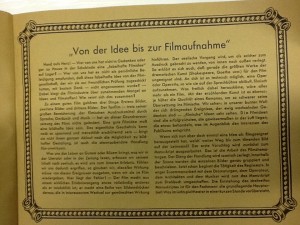By: Amy Chen, CLIR Postdoctoral Fellow
Still from Kuhle Wampe (1932). Hanson Tonfilmbilder. Film-Album Number 5. Dresden, Germany, 1932. Photographic Album.
Hall’s entertainment photographs (2008.030) includes an album that is comprised of over 120 photographs from more than forty films related to German film, actors, and actresses from the early 1930s.
The 1920s were a boom time for the German film industry; during this decade, expressionism developed as an alternative to the realist aesthetic, film criticism became a discipline, and good financing was available to directors. But film’s heyday was abbreviated when the nationalist right wing began to object to expressionism and enforced New Objectivity, a realist style known for “asphalt films” in the late 1920s. By the time the first talkies were made in 1932, the same year that the majority of Hall’s photographs date from, the relatively stable mid-war era was closing. Germany suffered from the effects of the Great Depression, which began in the United States, and, by 1933, Adolf Hitler would be sworn in as Chancellor, setting in place the political momentum that would give rise to the Third Reich and the Final Solution.[1]
Therefore, the 1932 film stills found in this album capture a unique moment in German history when the Weimar Republic fell to the Third Reich. The films from this year include Weimer patriotic fare such as Der schwarze Husar/The Black Husser (1932) and Die elf Schill’schen Offiziere/The Eleven Schill Officers (1932); the classic Kuhle Wampe/Who owns the world (1932), which is seen here and would later be banned by the Nazis for its communist themes;[2] and lighter options like the German adaptations of Oscar Wilde’s play The Importance of Being Earnest (1895), Liebe, Scherz und Ernst (1932) and Theodore Dreiser’s novel, An American Tragedy (1925), Amerikanische Tragodie (1932).
The album is in good condition; all of its pages are intact and show minimal wear. The following two pages are the album’s title page and an excerpt from the album’s introduction.
[1] Jennifer M. Kapczynski and Michael D. Richardson, “An Introduction to A New History of German Cinema: 1932,” A New History of German Cinema (Rochester, NY: Camden House, 2012), 1-11. See also: David Welch, “The History and Organization of Nazi Cinema,” Propaganda and the American Cinema, 1933-1945, Second Edition (New York, NY: St. Martin’s Press, 2006), 7-13.
[2] Franz A. Birgel, “Kuhle Wampe, Leftist Cinema, and the Politics of Film Censorship in Weimer Germany,” Historical Reflections/Reflexions Historiques 35.2 (Summer 2009), 40-62.




